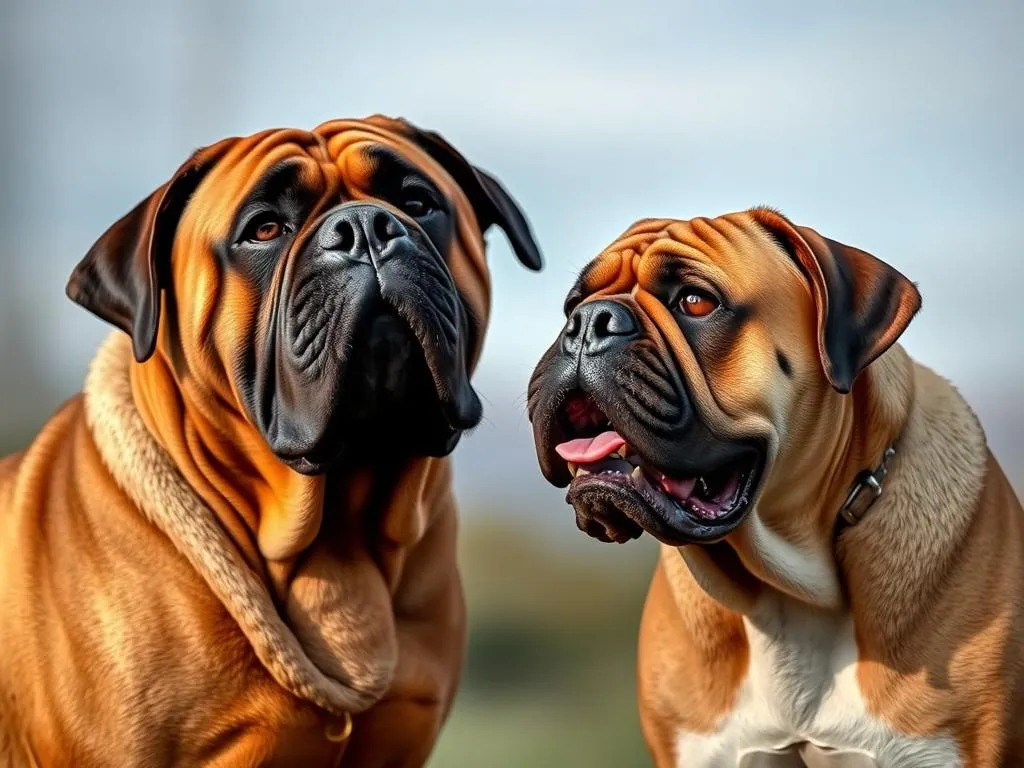
Understanding different dog breeds can significantly enhance the experience of pet ownership. Among the popular giant breeds, the Bullmastiff and the English Mastiff stand out for their impressive size and loyal nature. While both breeds share a lineage that speaks to their strength and protective instincts, they also exhibit unique characteristics that set them apart. This article delves into their histories, physical traits, temperaments, health considerations, training needs, and lifestyle compatibility to help potential owners make informed decisions.
Breed History
Bullmastiff History
The Bullmastiff originated in the late 19th century in England, primarily bred to serve as a gamekeeper’s assistant. These dogs were developed by crossing the English Mastiff with the Bulldog to create a breed that could effectively tackle poachers while being less aggressive than their predecessors. Their robust physique and keen sense of smell made them ideal for tracking and detaining intruders on estates.
Recognized by various kennel clubs, including the American Kennel Club (AKC) in 1934, the Bullmastiff has gained popularity not only for its guarding abilities but also as a loyal companion. Their unique blend of strength, loyalty, and gentleness has made them a desirable breed for families looking for both protection and affection.
English Mastiff History
The English Mastiff boasts a much older lineage, tracing back to ancient civilizations. This breed has been depicted in various historical texts and artifacts, including those from the Roman and Greek eras, highlighting its role in wars, guarding, and companionship. English Mastiffs were often employed in battle due to their size and strength, making them formidable opponents.
Over the centuries, these dogs have evolved from their war and hunting roles to become cherished family pets. The English Mastiff was recognized by the AKC in 1885, and their gentle demeanor and affectionate nature have contributed to their enduring popularity. Their historical significance and majestic size make them a symbol of loyalty and protection.
Physical Characteristics
Size and Weight
When comparing the Bullmastiff vs English Mastiff, size is a prominent distinguishing factor.
- Bullmastiff: Typically, they stand between 24 to 27 inches tall at the shoulder and weigh between 100 to 130 pounds.
- English Mastiff: This breed is larger, standing about 27 to 32 inches tall and weighing between 120 to 230 pounds, depending on the individual.
Both breeds grow rapidly during their puppy stage but can take up to two years to reach their full size. This slow maturation process is essential for their development, as it helps prevent skeletal issues later in life.
Coat and Color
Both breeds feature short, dense coats that require minimal grooming.
- Bullmastiff: The coat is typically fawn, brindle, or red, with a short, smooth texture that lies flat against the body.
- English Mastiff: This breed also comes in a variety of colors, including fawn, apricot, and brindle, with a slightly thicker coat that provides more insulation.
Grooming for both breeds is straightforward, requiring regular brushing to reduce shedding and maintain a healthy coat.
Distinctive Features
Each breed displays unique physical traits:
- Bullmastiff: Known for its powerful build and broad head, the Bullmastiff has a distinct muscular appearance. Its ears are small and pendant-shaped, and its facial expression is often described as serious yet gentle.
- English Mastiff: This breed has a more massive head and a wider body structure. The English Mastiff’s ears are also pendant but tend to be larger in proportion to its head. Their expression is often calm and dignified, reflecting their gentle nature.
Temperament and Personality
Bullmastiff Temperament
The Bullmastiff is renowned for its loyalty and protectiveness. These dogs are natural guardians, fiercely devoted to their families. They are generally calm and confident, making them excellent companions for children.
While they are friendly with family and familiar faces, they can be reserved and cautious around strangers. Bullmastiffs are known for their intelligence, which makes them responsive to training, though they can exhibit a stubborn streak. Early socialization is crucial to ensure they develop into well-rounded adults.
English Mastiff Temperament
The English Mastiff is often referred to as a “gentle giant.” These dogs are known for their calm demeanor and affectionate nature. They tend to be very sociable, getting along well with children and other pets.
Despite their size, English Mastiffs are not aggressive; instead, they exhibit a protective instinct without being overly confrontational. They are generally laid-back and prefer lounging around the house, making them suitable for families who appreciate a more relaxed pet. However, like the Bullmastiff, early socialization is essential for their development.
Health Considerations
Common Health Issues
Both breeds are susceptible to specific health concerns due to their size.
-
Bullmastiffs: Common issues include hip dysplasia, elbow dysplasia, and certain heart conditions. They may also suffer from bloat, a potentially life-threatening condition that affects large breeds.
-
English Mastiffs: This breed is prone to similar health issues, including hip and elbow dysplasia, bloat, and certain types of cancer. Regular veterinary check-ups are essential for early detection and management of these conditions.
Lifespan and Care
The average lifespan for both breeds tends to be shorter than that of smaller dogs:
- Bullmastiff: Typically lives around 8 to 10 years.
- English Mastiff: Generally has a lifespan of 6 to 10 years.
Both breeds require routine veterinary care, including vaccinations, dental cleanings, and preventive measures against parasites.
Diet and Nutrition
Nutrition plays a critical role in maintaining the health of both breeds.
-
Bullmastiffs: Require a diet formulated for large breeds, focusing on high-quality protein sources and balanced nutrients. Portion control is vital to prevent obesity, which can exacerbate health issues.
-
English Mastiffs: Their dietary needs are similar, but due to their larger size, they may require proportionally more food. It’s crucial to provide a well-balanced diet that supports their slower metabolism and growth patterns.
Training and Socialization
Training Methods
Training is essential for both breeds, emphasizing positive reinforcement techniques.
-
Bullmastiff: Due to their strong-willed nature, consistency and patience are key. Early obedience training can help mitigate any stubborn tendencies, ensuring they grow into well-behaved adults.
-
English Mastiff: These dogs are generally eager to please, making training relatively straightforward. However, their size necessitates teaching commands early on to ensure safe, manageable behavior.
Socialization Tips
Both breeds benefit significantly from early socialization:
- Introduce them to various environments, people, and other animals to develop confidence and reduce potential fear-based reactions.
- Puppy classes and playdates with well-mannered dogs can provide valuable experiences that promote positive behavior.
Living Conditions
Space Requirements
Both breeds are large and require ample space, but their needs can vary.
-
Bullmastiffs: While they adapt well to various living conditions, they thrive in homes with access to a secure yard. An apartment may work if they receive sufficient daily exercise.
-
English Mastiffs: These dogs prefer a spacious environment due to their size. A house with a yard is ideal, as they enjoy lounging outside but also need room to move around comfortably.
Exercise Needs
Exercise is vital for both breeds to maintain a healthy weight and avoid behavioral issues.
-
Bullmastiffs: Require about 30 to 60 minutes of exercise daily. This can include walks, play sessions, and mental stimulation activities.
-
English Mastiffs: Need slightly less exercise, typically around 30 minutes per day. Their laid-back nature means they may be content with leisurely walks and indoor play.
Choosing the Right Breed for You
Considerations for Bullmastiff Owners
Potential Bullmastiff owners should consider their lifestyle:
- They thrive in active families who can commit time to training and socialization.
- Homes with older children may be preferable, as Bullmastiffs can inadvertently knock over smaller kids due to their size and playful nature.
Considerations for English Mastiff Owners
English Mastiff owners should reflect on their living environment and family dynamics:
- Ideal for families seeking a gentle, calm companion who enjoys relaxation.
- They require less exercise than Bullmastiffs, making them suitable for less active households.
Conclusion
In the comparison of Bullmastiff vs English Mastiff, both breeds offer unique advantages and characteristics. While the Bullmastiff is known for its guard dog instincts and loyalty, the English Mastiff shines in its gentle and affectionate demeanor. Understanding the key differences and similarities between these two breeds is crucial for making an informed decision.
Ultimately, potential owners should consider their lifestyle, living conditions, and personal preferences when selecting between these two magnificent breeds. Whether one chooses the protective nature of the Bullmastiff or the gentle giant qualities of the English Mastiff, both breeds promise to bring love and loyalty into any home.
Frequently Asked Questions (FAQs)
What is the average lifespan of a Bullmastiff vs. an English Mastiff?
The average lifespan of a Bullmastiff is around 8 to 10 years, while an English Mastiff typically lives between 6 to 10 years.
Are Bullmastiffs more aggressive than English Mastiffs?
Bullmastiffs can be more protective and reserved around strangers compared to the generally more sociable English Mastiff, which is known for its gentle demeanor.
How much exercise do these breeds need?
Bullmastiffs require about 30 to 60 minutes of exercise daily, while English Mastiffs usually need around 30 minutes.
Which breed is better with children?
Both breeds can be great with children, but English Mastiffs tend to be more patient and laid-back, making them especially good companions for families. Bullmastiffs are also protective and affectionate but may be better suited for families with older children.









